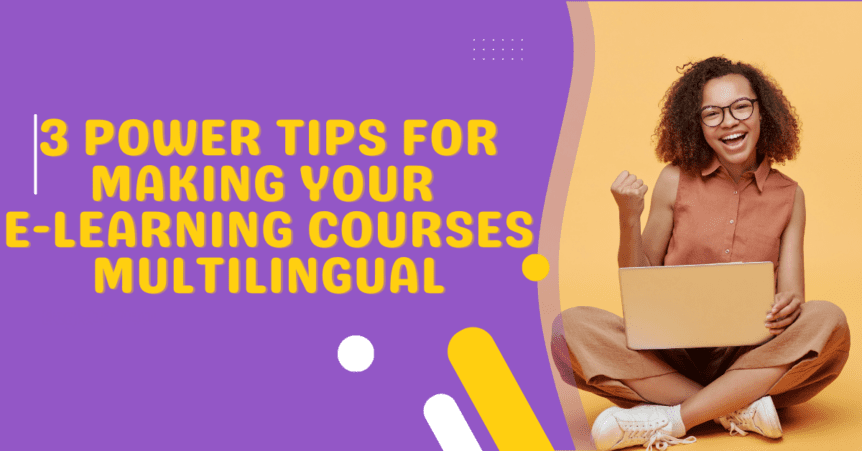3 Power Tips for Making Your E-Learning Courses Multilingual
Creating multilingual e-learning courses enhances the learning experience for learners. This applies to learners who don’t speak the original language of the course as well as those who speak the original language as a second language.
Transforming your e-learning course into a multilingual e-learning course isn’t as straightforward as running the text through an automated language translator. In fact, if that is all you do, you could damage the learning experience rather than enhance it.
Creating a multilingual course requires proper planning and careful consideration through all content development stages. Here are our three power tips.
Write the Original Text with Translation in Mind
We are going to start with text as text is often the cornerstone of e-learning courses and it is the main element that needs to be translated to make your course multilingual. The main challenge you need to overcome is writing text that remains difficult to understand even after it has been translated. It is equally important to ensure the translated text doesn’t insult learners.
For these reasons, you should write the original text with the various translations in mind. Here are the main things to consider:
- Jargon – it is better to avoid jargon. Where it can’t be avoided, consider including an explanation.
- Slang – local slang terms should also be avoided.
- Cultural references – avoid cultural references, too, as they can be misunderstood or difficult to understand for people in other locations. This includes everything from movies, TV shows, and music to local cultural references.
- Localised terms – the same applies to localised terms and phrases. Localised terms and phrases can have no direct translation, the translation might not make sense, and it might even cause offence. Therefore, localised terms are best avoided.
- Symbols, numbers, and icons – symbols and icons can differ across different languages. This includes how numbers and currencies are represented. Weights and measurements can be different too. You should also be careful to ensure icons and symbols are universally understood and won’t cause offence to any learners.
- Technologies – technologies that are common in your area might not be common or even available to some groups of learners who will complete the course. This should be considered if you are referencing particular technologies in the text.
- Space and direction – translated text can be shorter or longer than the original, and the text can run in a different direction. All of these factors can have an impact on the design of your e-learning course and, ultimately, the learning experience.
Plan for Multilingual Multimedia Elements
Text isn’t the only element that will benefit from translation when you are creating a multilingual course. The multimedia elements are important too, especially those multimedia elements that are crucial to the learning experience, learner engagement, and the success of the course. Examples include infographics, videos, and animations.
The main things to consider include:
- Videos – with videos you have the option of recording a new voiceover or adding subtitles. If recording a new voiceover, consider the timings as the translated voiceover could take longer or shorter to say. It can also be beneficial to provide the voiceover artist with pronunciations for difficult-to-pronounce or unusual words.
- Audio – the same advice for video applies to audio, i.e., timings and pronunciations.
- Animations – animations are important as it is common to have both a voiceover and text on the screen with animations. The text on the screen needs to be translated following the tips in the section about writing text.
- Graphics – the same applies to graphics, i.e., text, numbers, symbols, etc all need to be translated taking into account the considerations mentioned earlier in this blog.
Include a Multilingual AI Tutor
One of the most neglected areas when creating multilingual e-learning courses is the help content and supplementary materials (guides, FAQs, additional reading, etc). You should consider translating all of these elements.
For the best results, you should also include an AI tutor in your e-learning course. At Capytech, we are industry leaders in the development of AI tutors for e-learning courses, and all our AI tutors can be multilingual.
An AI tutor created for your e-learning course will be trained only on your organisation’s materials, restricting its knowledge to the topic of the course. Learners can then interact with the AI tutor to get additional information, clarification on a point they don’t understand, or more information about a particular element of the content.
Including an AI tutor will create a buzz around your e-learning course and will enhance engagement in addition to improving the learning experience. The fact the AI tutor can be multilingual will elevate your course even further.
Benefiting from Multilingual E-Learning Courses
You will have specific goals and objectives when creating an e-learning course, from achieving behavioural change to ensuring return on investment to bridging skills gaps identified in the business. If you have learners who speak different languages, making your e-learning courses multilingual will help to achieve all these goals and objectives.
